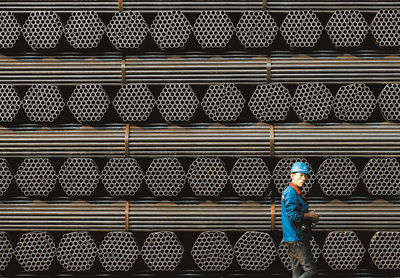
LI TE, owner of an iron ore works in Benxi City, Liaoning Province, feels it was a wrong decision to invest in the steel sector a few years ago, as excess production capacity has been a problem nationwide for years.
His factory stopped production half a year ago. “We cannot get paid for our goods and, in any case, sales were bad,” said Li. “We are only just surviving with the burden of loan interests.”
Many companies in Northeast China, an old industrial belt, face similar difficulties. In Liaoning, 16.5 percent of enterprises above a designated size suffered losses in the first half of the year. In the first three quarters, Liaoning reported the lowest economic growth of 2.7 percent year on year among 31 provinces, municipalities and regions.
The growth for the first three quarters was 6.3 percent and 5.5 percent for Jilin and Heilongjiang provinces, also in the northeast, and both lower than the country’s 6.9 percent in the same period.
Due to the grim prospects, more than 10 percent of enterprises in Heilongjiang halted production in the first half of the year.
Shao Zongju’s machinery factory is one. The manager of the plant in Qiqihar, an industrial town of Heilongjiang, is now the only guard at the quiet premises.
In the Fulaerji district of Qiqihar, nearly half of the enterprises stopped or cut production in the first half of the year.
“When economy grows rapidly, even some less competitive companies can still performs well, but when it slows down, we see a big reshuffle,” said Liu Shijin, former deputy director of the State Council Development Research Center.
The slowdown in heavy industry, chemicals and the real estate sector has been partly blamed for situation facing regions like Northeast China. From 2003 to 2012 average annual growth in Northeast China was close to 13 percent. State-owned enterprises (SOEs) and energy industries play an essential role in the region’s economy.
Growth slowed sharply in 2013. Industrial restructuring and market-oriented reforms over the past decade saw much less progress than expected, with poor investment in new products or ideas.
In August 2014, the Central Government announced a new plan to boost the northeast with a list of measures to free up private businesses and reform the SOEs.
“The private sector in Northeast China seems to be growing rapidly, but it is dependent on the State-owned sector,” said Jiang Minghui, a researcher with Harbin Institute of Technology (HIT). He compares small and medium-sized private firms in the region to vines attached to trees (large SOEs). He does not expect much without serious SOE reforms.
Chi Fulin, director of the China (Hainan) Institute for Reform and Development, wants a free trade zone in the northeast to help equipment exports. Investment and attention is shifting to innovation and talent in the search for efficient growth. In December 2014, HIT Robot Group was founded in Harbin, capital of Heilongjiang, to support the high-tech industry.(Xinhua)
|

